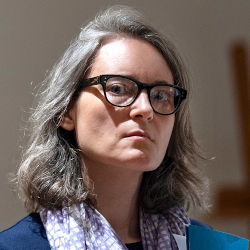
Tanya Sheehan is Ellerton M. And Edith K. Jetté Professor of Art, Colby College and the 2024-2025 Consortium Albert M. Greenfield Research Fellow.
After Harlem Hospital explores American modernism’s engagement with medicine by focusing on the circle of artist Charles Alston, who co-directed the Harlem Art Workshop in New York City and supervised the federally funded mural project at Harlem Hospital between 1936 and 1940. The book sheds new light not only on a historical group of understudied African American artists but also on the long and troubled relationship between race and medicine. In the United States, we were reminded of this relationship most recently in 2020, when an emerging coronavirus pandemic that disproportionately affected Black Americans intersected with widespread protests against systemic racism, sparked by the death of George Floyd at the hands of the police. The Secretary of the Smithsonian Institution has referred to these events as America’s “dual pandemics—the first a pandemic of illness, and the second a pandemic of racism.” While he also said that 2020 was “like no other moment in American history,” my scholarship shows that there are deep connections between the present and the past. African American artists working over the last decade—Derrick Adams, Vanessa German, LaToya Ruby Frazier, Simone Leigh, and others—have been uncovering those connections by making visible racial inequities in both the history and contemporary practice of medicine. Although many Americans now see the COVID-19 pandemic as behind us, these artists show how urgently we must imagine new ways of caring for and in Black communities.
With the support of a CHSTM Fellowship, I was able to conduct research at two key sites: New York Academy of Medicine (NYAM) in December 2024, and Augustus C. Long Health Sciences Library at Columbia University in February 2025.
At NYAM, I consulted a wide variety of primary sources, from medical books and periodicals to postcards, scrapbooks, and other ephemera. My research focused on better understanding several topics: the history of Harlem Hospital as a professional and community space for African Americans; the social dimensions of healthcare in Harlem at midcentury; medical illustration in this period, both hand-drawn and photographic; and the administration of creative and recreational therapies in institutional settings. The first two of these topics were crucial to the contextualization of the book’s case studies from the history of art, an example of which is Jacob Lawrence’s depiction of the persistently overcrowded outpatient clinic at Harlem Hospital, where Black patients struggled to receive adequate or efficient care. Acquiring a deeper understanding of the principles and practices of medical illustration has been essential to developing critical questions about Charles Alston’s illustrations for Dr. Louis T. Wright’s publications of clinical case studies from Harlem Hospital in the 1940s and 50. Finally, creative and recreational therapies were at the center of the treatment for mental illness that Lawrence underwent himself at Hillside Hospital in Queens, and represented in paint, around 1950.
Because Harlem Hospital Center became affiliated with the College of Physicians and Surgeons at Columbia University in 1962, I was able to access at Columbia some administrative files related to the operations of Harlem Hospital. Relevant to my research were files within the Office of the Assistant Dean (Yahr) Records, which contain summaries of committee meetings in which hospital administrators discussed their goals for care in/for the Harlem community. Documents in the Dean’s Office Collection discuss the competition between medical societies for Black doctors in Harlem, the development of the Negro National Hospital Fund, the education of Black medical students and the relatively low numbers of Black students in medical schools like Columbia’s, and ongoing efforts to racially integrate hospital staff. I intend to use these primary sources to support my readings of artists’ depictions of Black patients and doctors in Harlem and my arguments about both Lawrence and Alston’s engagement with the pioneering work of Louis T. Wright, who led the Manhattan Medical Society and the reorganization of Harlem Hospital to diversify its staff.
The sources I acquired from these two important New York medical libraries are allowing me to write more accurately and insightfully about the intersection of artmaking and medical care in Harlem in the middle of the twentieth century. They have also pointed me to additional collections related to hospital practices in Harlem that are now housed at the New York Public Library, from the Gene-Ann Polk Harlem Hospital Center Files (1930-2005) to the papers of mental health professionals Elizabeth Bishop Davis and June Jackson Christmas. I intend to consult these collections in 2025-26, while continuing to prepare my manuscript for publication. I remain grateful to the CHSTM for offering such a generous research fellowship to support my book project.